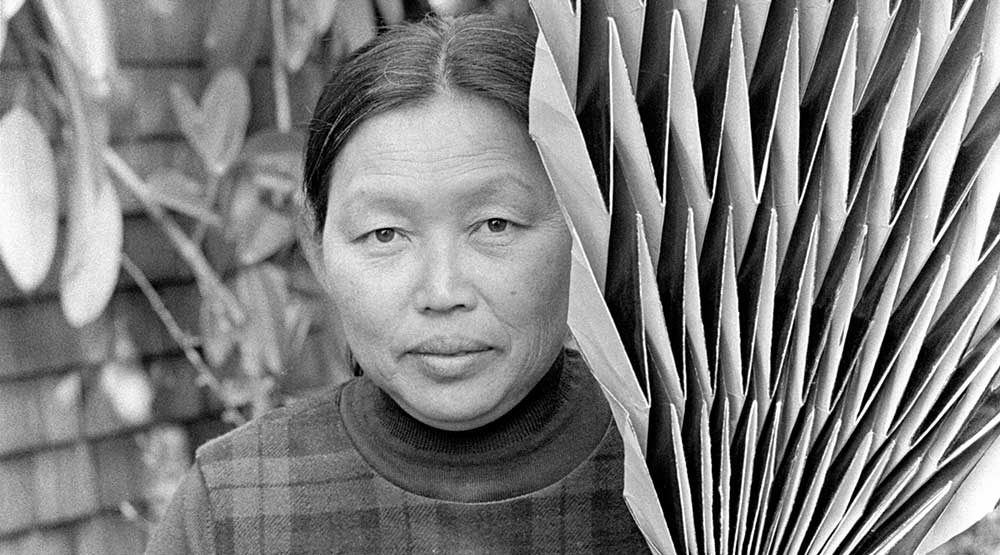
Laurence Cuneo, Ruth Asawa holding a paperfold, c1970s (detail). Gelatin silver print, 9 13/16 × 7 5/16 in (24.9 × 18.6 cm). Courtesy of the Department of Special Collections, Stanford University Libraries. Photograph © Laurence Cuneo. Artwork © 2023 Ruth Asawa Lanier, Inc. / Artist Rights Society (ARS), New York. Courtesy David Zwirner.
by LILLY WEI
Ruth Asawa (1926 -2013) is best known for intricate wire sculptures so delicate in appearance that they seem truly drawings in space. Through Line, now at the Whitney Museum of American Art, is an in-depth look at he drawings and their crucial role in a practice that burnished the ordinary in a uniquely compatible marriage between fine art and craft. It was co-organised with the Menil Collection in Houston and co-curated by Kim Conaty, the Whitney Museum’s curator of prints and drawings, and Edouard Kopp, the chief curator of the Menil Drawing Institute, where it will be exhibited after closing in New York.
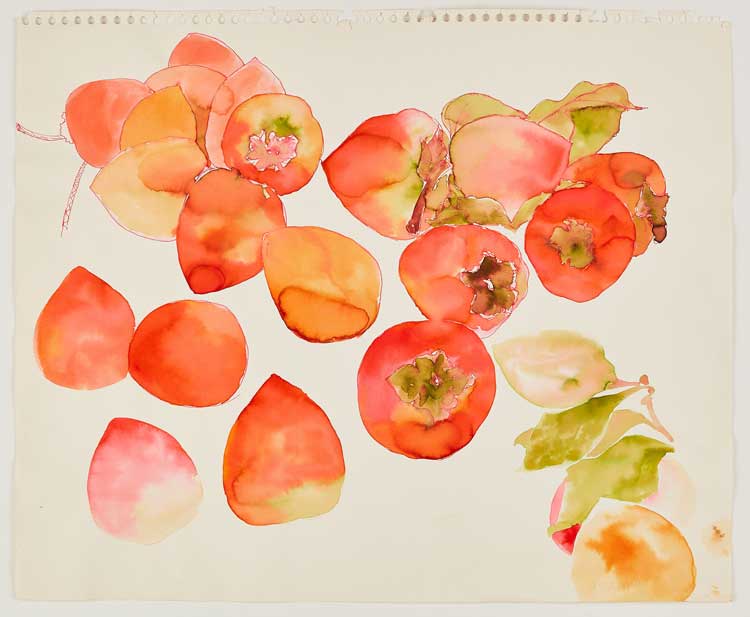
Ruth Asawa, Untitled (WC.252, Persimmons), c1970s–80s. Watercolour on paper, 14 × 17 in (35.6 × 43.2 cm). Private collection. Artwork © 2023 Ruth Asawa Lanier, Inc. / Artists Rights Society (ARS), New York. Courtesy David Zwirner.
The following is an edited and excerpted conversation between Conaty and Lilly Wei about the exhibition.
Lilly Wei: Through Line, the Asawa show, is the first to study her drawings, which are wonderful. And those who only know her wire sculptures will have some delightful surprises in store. Could you tell us a little about the origins of this show and what draws you particularly to her work?
Kim Conaty: I started in 2017 at the Whitney and oversaw the acquisition committee, specifically for drawings. At my first committee meeting, we discussed her works on paper. I had seen her potato prints at David Zwirner and have always loved them and, in researching, I began to understand the breadth of her drawing process. In 2018, I met her family in San Francisco, which was critical in thinking about a show of her drawings. Drawing was the activity that she pursued throughout her life and an important force, the sculpture clearly coming from it, wire the equivalent of line. It’s the way she talks about it, that line can go anywhere. It was literally the through line of her work since childhood. To understand her creative output, you need to understand her drawing practice and that it was something she did daily. She also never had a show of just her drawings – and she very much wanted one.
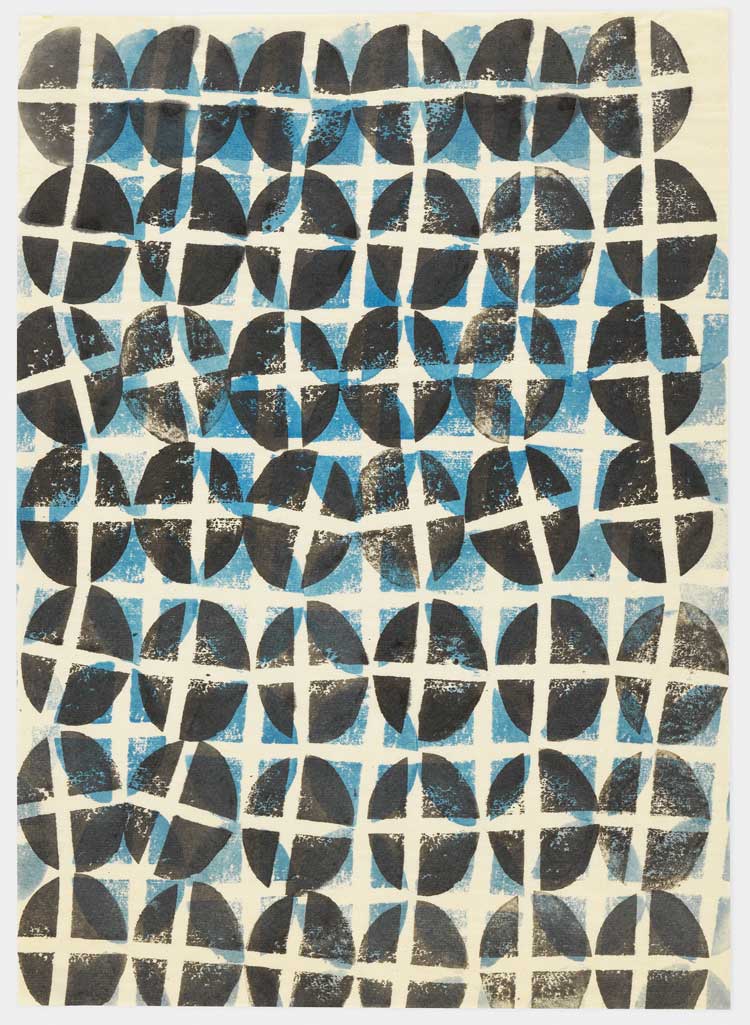
Ruth Asawa, Untitled (SF.047a, Potato Print – Cross, Blue/Black), c1951–52. Stamped ink on Japanese paper, 14 1/4 × 10 in (36.2 × 25.4 cm). Private collection. Artwork © 2023 Ruth Asawa Lanier, Inc. / Artists Rights Society (ARS), New York. Courtesy David Zwirner.
LW: Has she had a major museum retrospective of her work in New York? Why a drawing show and not more of a survey?
KC: During her lifetime, she received recognition for her work and had several solo exhibitions. There was a survey in San Francisco in 2006 at the De Young Museum (Fine Arts Museums of San Francisco) and, more recently, she had one at the Pulitzer Arts Foundation in St Louis in 2018. It was not a traditional retrospective, but seeing the drawings in that show was another incentive to do this one. I like the idea of taking a moment to look at an artist’s practice in a precise and focused way. Curators think about this. We integrate mediums, but on occasion, it’s good to isolate one aspect of a practice. It reveals something that another kind of show wouldn’t be able to do.
LW: Would you talk about her background a little and how that might have influenced her work?
KC: Asawa was born in 1926. She was one of seven siblings and grew up on a farm in southern California. And this was so important, her growing up with a tremendous work ethic, working with her hands, able to work with her left hand, with her right hand. She had little free time, but she let her imagination wander when she was working. It was very much not her experience to wander the Metropolitan, to leisurely gaze at art. Her experience was of nature. Also of major importance was her Japanese education; she went to a Japanese school at weekends, where she learned the language and origami and calligraphy, which had a lasting impact on her work.
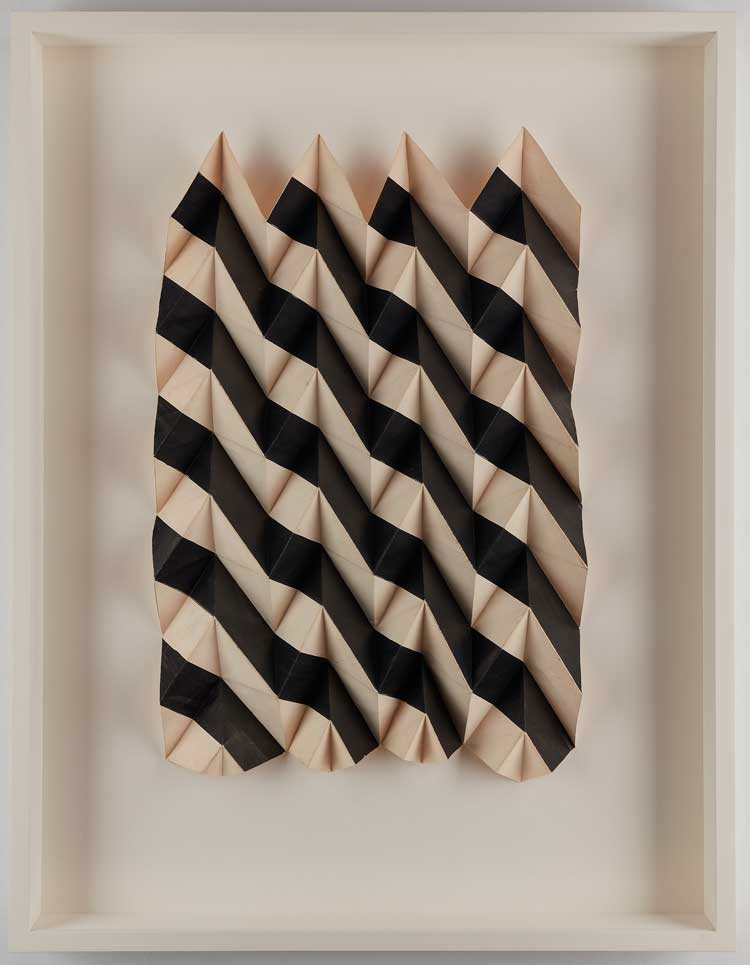
Ruth Asawa, Untitled (S.843, Mounted Paperfold with Diagonal Black and White Stripes), c1952. Ink on paper, 17 5/8 × 11 3/4 × 1 1/8 in (43.2 × 29.8 × 2.9 cm). Private collection. Artwork © 2023 Ruth Asawa Lanier, Inc. / Artists Rights Society (ARS), New York. Courtesy David Zwirner.
When she went to study at Black Mountain College, the pedagogy there related to how she was living her life already. When she was learning paper-folding from Josef Albers, she already knew about it from origami, and the idea of keeping the eye ahead of the pencil related to what she knew from calligraphy. In 1949, she left Black Mountain to join her husband, Albert Lanier, an architect, whom she met there, in San Francisco where they married and stayed for the rest of their lives. She also starts making her wire sculpture in 1949. They were collected by major collectors and institutions, and she was in three Whitney annuals, and began studying with a Buddhist monk, integrating more calligraphy into her work, and did commercial projects with her husband.
LW: She was also placed in an internment camp with her family when she was 16 in 1942. She met her first professional artists – other Japanese Americans interned there – and said for that, she was grateful, since it changed the course of her life. Nonetheless, I thought it was extraordinarily generous of her to think that, to have no bitterness.
KC: She was generous, and there is a great deal of generosity in these works.
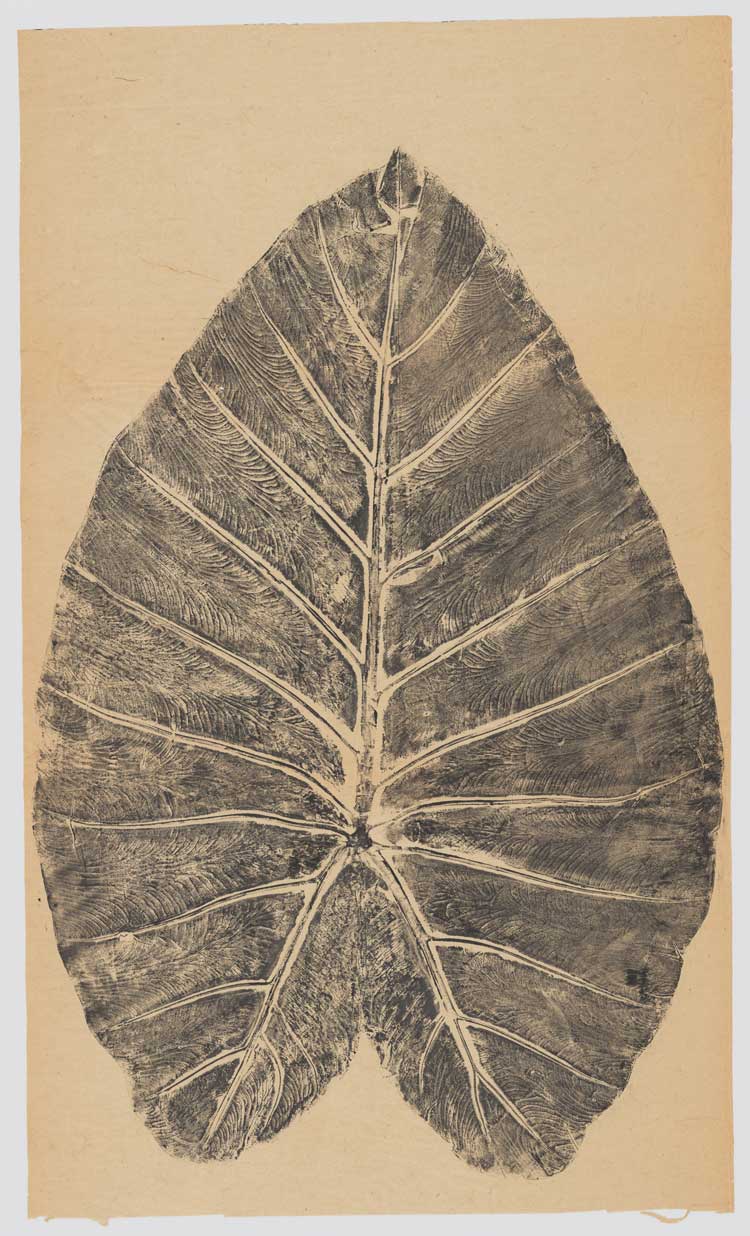
Ruth Asawa, Untitled (Leaf from the Sacramento Delta), c. early 1990s. Ink on Japanese paper, 43 1/8 × 25 11/16 in (109.5 × 65.3 cm). Courtesy the Department of Special Collections, Stanford University Libraries. Artwork © 2023 Ruth Asawa Lanier, Inc./Artists Rights Society (ARS), New York. Courtesy David Zwirner.
LW: Could you discuss the organisation of Through Line? You divided the show into eight thematic sections, which presents the works in a non-chronological way.
KC: The categories started with a great many more, but we reduced them to eight eventually. I say “we”, because I worked very closely with Edouard Kopp. A chronological approach didn’t feel right to either one of us. It was because we thought it should come out of the work itself, and because Asawa would work through a motif, and then return to it 10 years later, then perhaps again 15 years later, as if in a looping pattern. The themes, the categories came out of that as we followed the through lines in her work. We thought a lot about the motifs, materials, and the questions she was asking herself. In Growth Patterns, one of the sections, it wasn’t just about plant growth. She was thinking about a central motif, about a pattern emanating from a centre. And in Rhythms and Waves, there is the Greek meander pattern, which she returns to, representing the waves of oceans, the hills of San Francisco, and so on.
LW: Were there some works you thought were crucial to the exhibition, to understanding her work? And would you talk about one or two of them specifically?
KC: I could come up with many different examples. One group that was very important for us were the paper folds. They were a part of her practice that I had heard about, and I had seen one prior to doing research for the show, but I had no idea then how important they were for her. They had the capacity to bridge her upbringing, and were part of her muscle memory of origami, a link to Black Mountain, and to understanding that paper- folding was about structure, strength and memory. It becomes a key tool for her when she is doing teaching outreach in the San Francisco school system. She thought folding was the key to developing a certain spatial intelligence which is felt throughout her work. The folded paper work that is not framed in the show is very special. It had been kept flat, stored away, and rarely unfolded in 50 years. The first time we saw it unfolded was like lightning had struck.
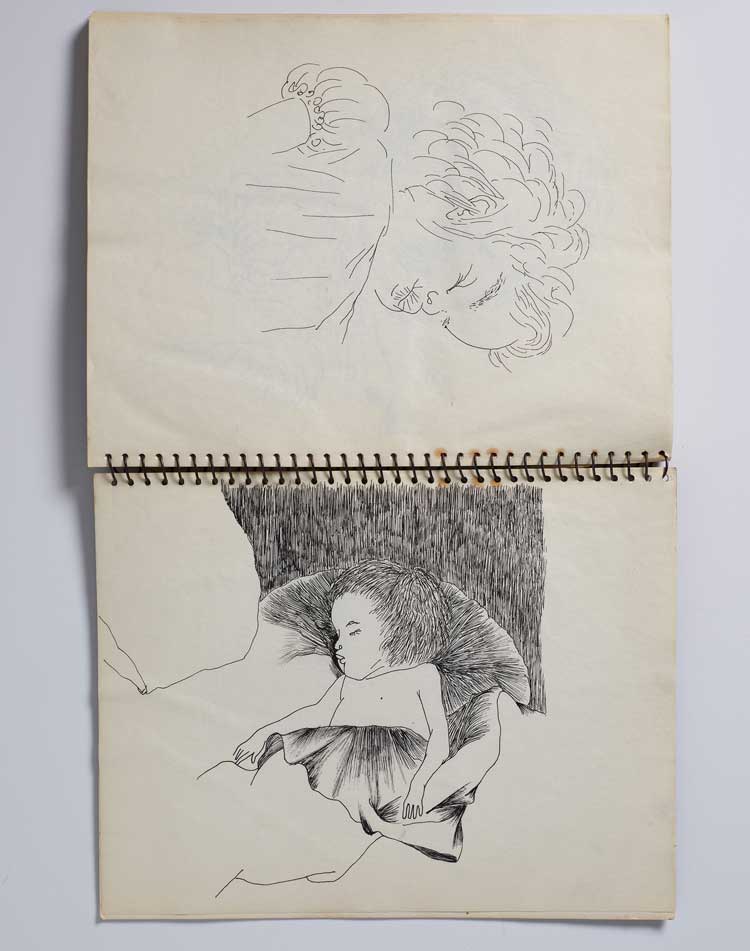
Ruth Asawa, Untitled drawings of Addie Lanier sleeping (SB.013), c1960. Ink on paper in spiral-bound sketchbook, 16 1/2 × 11 in (41.9 × 27.9 cm). Private collection. Artwork © 2023 Ruth Asawa Lanier, Inc. / Artists Rights Society (ARS), New York. Courtesy David Zwirner.
LW: When you were researching the show, were there surprises?
KC: There was surprise after delightful, thrilling surprise. We might find a watercolour, and wonder which side was meant to be shown since she had signed the works on both sides. Or we might notice a stencil in one work and see it used somewhere else. And looking at her sketchbooks and seeing this life on a daily basis, I was bowled over by that. Plus seeing her children’s drawings, their stick figures, in there with hers. And there were the surprises in the installation as I made changes to the groupings at times. Asawa was an extremely resourceful artist, and we see that throughout the works on paper; the section, Found and Transformed, deals with that. She used what she found in nature, like weeds, leaves, potatoes, fish. Her family would bring her objects and one of her sons was a skilled fisherman.
LW: I loved the fish print.
KC: It’s called gyotaku in Japanese and is part of long tradition that goes back to the days of the samurai. They were used not only for inventory purposes but also to boast about your catch, like taking photos today.
LW: And how do you make them?
KC: One method is to wipe the fish dry, then sponge ink across the scales, then lay paper on top to absorb the ink.
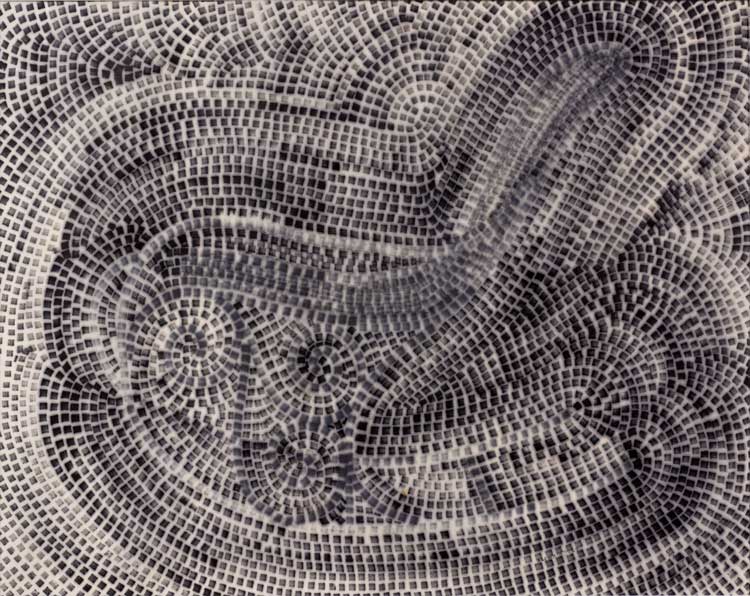
Ruth Asawa, Bentwood Rocker (MI.176), c1959–63. Felt-tipped pen on paper, 18 × 22 3/4 in (45.7 × 57.8 cm). Black Mountain College Museum + Arts Center; gift of Rita Newman. Artwork © 2023 Ruth Asawa Lanier, Inc. / Artists Rights Society (ARS), New York. Courtesy David Zwirner.
LW: How do her works on paper contribute to her sculptural projects and the reverse?
KC: One of the sections, Forms within Forms, tackles head-on this fluid relationship between her two-dimensional works and her wire sculptures and it includes some works she did at Black Mountain that were inspired by dancers in Merce Cunningham’s company. She also took science classes, and her science notebooks are filled with drawings of one organism swallowing another. Using Zipatone (once popular, now obsolete, pressure sensitive pattern sheets), she would collage patterns together and create shapes like her sculpture. The visual effects were dynamic, moving from drawing to negative space, extending into the three-dimensional, then into the two-dimensional, then back again, looping.
LW: How would you situate her in a contemporary context?
KC: I think we are in an interesting moment within institutions. I think we understand that audiences want to see new things in addition to things they already know, so that there is a sense of connection between the known and the new. I felt that strongly when I curated the Edward Hopper show here. I knew our visitors expected certain works, but how do I show them something new, or from a new point of view, that would add in interesting ways to what they were seeing?
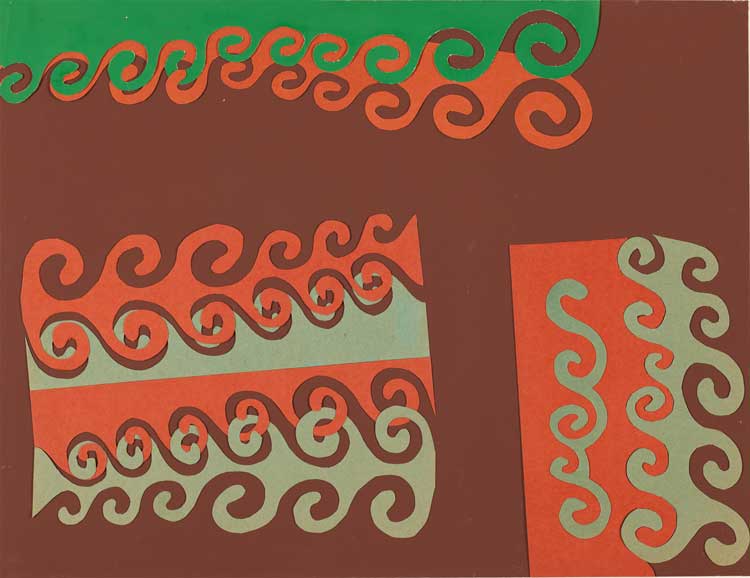
Ruth Asawa, Untitled (BMC.127, Meander in Green, Orange, and Brown), c. 1946-49. Collage of coloured papers mounted to brown paper, 17 1/4 × 22 3/8 in. (43.8 × 56.8 cm). Harvard Art Museums/Busch-Reisinger Museum; gift of Josef Albers. Artwork © 2023 Ruth Asawa Lanier, Inc. / Artists Rights Society (ARS), New York. Courtesy David Zwirner. Photo © President and Fellows of Harvard College, BR49.408.
It was a little bit like that for the Asawa show. Audiences know the sculptures, so you don’t want to shy away from that. But there is so much more to share. The beauty of Asawa’s work is her very human way of making art, her closeness to nature, and her ability to see beauty in the most ordinary things. Yes, she is a woman, and her artistic career suffered because of that earlier. She had proposed a show of her drawings several times, but drawings weren’t considered important enough then. That has changed. Our visitors want a fresh perspective. This is what these works on paper have and this is what she wanted to share. I believe that this is the show she always wanted to have.
• Ruth Asawa: Through Line is at the Whitney Museum of American Art, New York, until 15 January 2024.